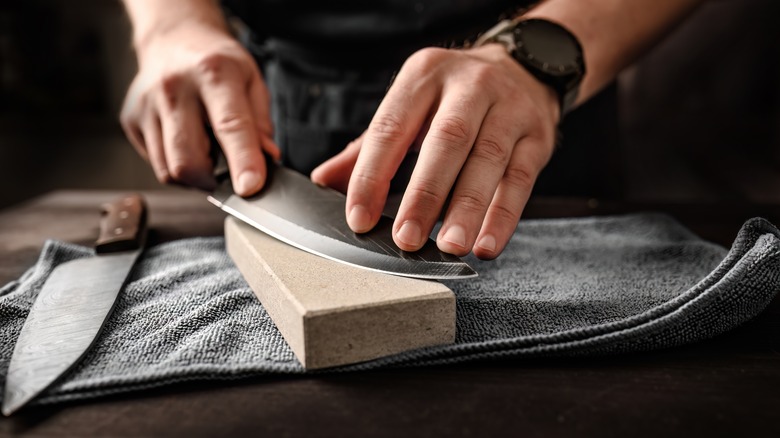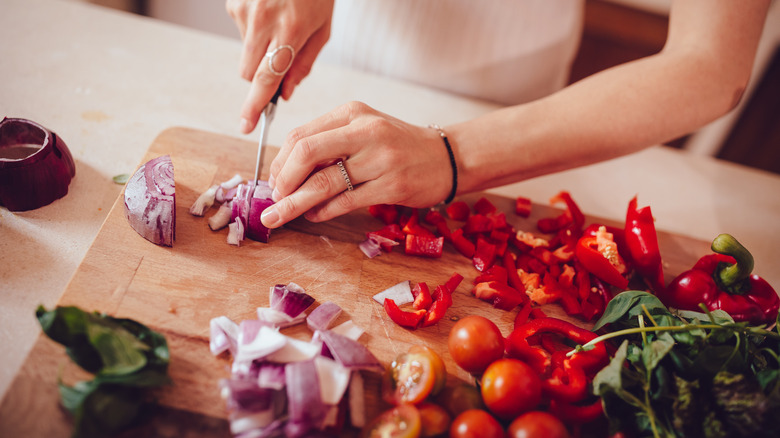Ina Garten's Clever Trick For Keeping Your Knives As Sharp As Possible
The mark of any great chef is not just the final product in the kitchen, but the tools they utilize. Anyone can cook like a professional so long as they adhere to simple maintenance with the most important utensils for cooking. No kitchen set is complete without knives, and no knives can be useful without the sharpest edge. A best practice is to sharpen knives every month or so with a stone or rod to ensure pristine sharpness. But even while keeping up with these good habits, there are still kitchen mishaps that can impede the fine points of your knives.
Everyday occurrences can dull your knives, which The Barfoot Contessa, Ina Garten, noted in an Instagram post. If you store your knives in a customary butcher's block, the wood edges can impact your knife set. Garten recommends flipping the knife blades side up when storing in such a block. This practice will leave space between the blade's edge and the wooden block so it doesn't scrape against the edge of your kitchen utensil. While a small step, this will ensure the longevity of your favorite knife set.
Other ways to keep a sharp edge
Keeping your cherished knives away from any surface that can dull them is just one part of the equation. Cutting on marble or glass cutting boards is a death sentence and will speed up the dulling process. But the other kitchen essential is making a concerted effort to sharpen your knives on a routine basis. Investing in the proper knife-sharpening equipment will significantly step up cooking prowess in the kitchen. The primary way to keep your knives sharp is to use a honing rod or sharpening stone. Like any period piece that features a knight or blacksmith dragging his sword against a large rock, the principle is essentially the same in modern times.
A whetstone is one of the most efficient ways to transform a dull blade not fit for chopping into one with the sharpest edge. Hold the blade at an approximately 15-degree angle for best results. Drag the knife's edge repeatedly so it shaves down the edges of the blade that have dulled. You will know that you have accomplished your goal simply by testing its efficiency the next time you are preparing a meal. The knife should slice through vegetables and meat like butter.
Benefits of sharp knives
Buying a tool specifically designated for maintaining just one type of utensil may seem like a luxury. For those on a budget or who don't consider themselves kitchen connoisseurs, it may not seem worth it to buy your very own whetstone. However, there is more to maintaining your knives than just chopping up a salad quickly. Using a properly maintained knife will require less effort when cutting because you don't need as much energy as when the knife is dull. This way is much safer than chopping ingredients with a dull knife, which could be dangerous in extreme circumstances.
Sharp knives are also much healthier for your food as well. Food has cells that are easily damaged when cutting with a dull knife. Damaged cells are particularly evident when cutting onions. Who among us hasn't been consumed with painful tears after cutting vegetables for soups or salads? With a sharp blade, you are less likely to hurt the cells in the onion and produce a waterfall of tears. In addition to saving yourself from pain while vegetable cutting, it also helps keep the food fresh. Dull knives can accelerate the decomposition process since you are crushing the food instead of cutting through it cleanly. With more control in the kitchen, there is no reason not to utilize Ina Garten's clever hack.


